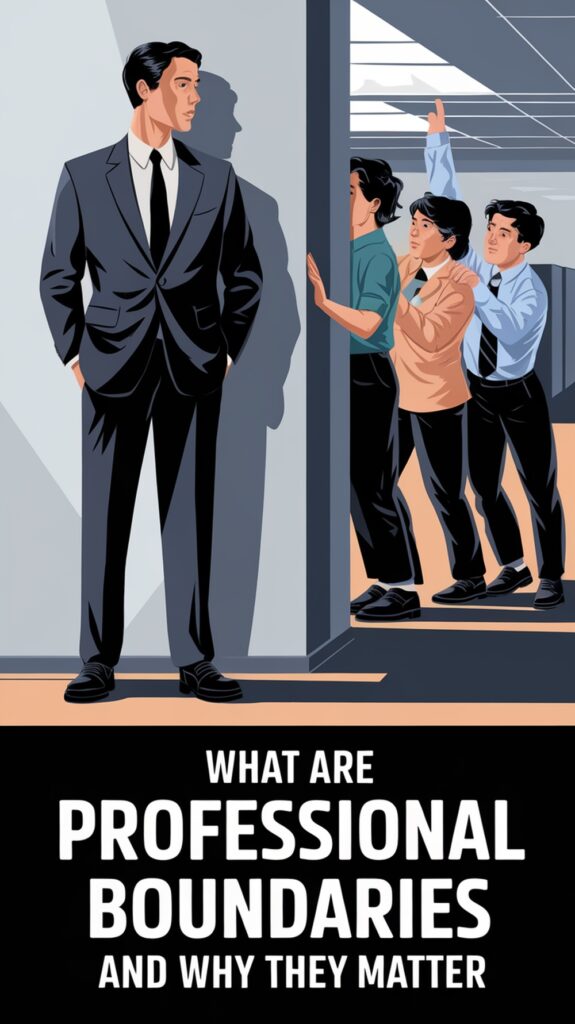Professional boundaries are the rules that help define what is acceptable in workplace relationships. These boundaries are important for building a space where trust, safety, and respect can grow. If boundaries aren’t clear, workers could face problems.
This can lead to misunderstandings or legal troubles. By following ethical guidelines and sticking to a code of ethics, professionals can maintain appropriate boundaries at work. This helps improve productivity and makes collaboration more pleasant for everyone.
Jump To Section
What Are Professional Boundaries?

What Constitutes a Professional Boundary?
A professional boundary helps keep workplace relationships respectful and professional. It also follows the organization’s codes of ethics. These boundaries define the roles of professionals and stop them from becoming overly involved or emotionally attached. For instance, a manager should show empathy but should not solve personal issues for employees.
Keeping appropriate boundaries in professional relationships protects everyone. This is very important in jobs like health care and social work, where workers hold a position of power or guidance over their customers. In these roles, it’s essential to be sensitive and aware to prevent ethical problems.
When everyone respects boundaries, teamwork grows. Professionals can talk openly and trust that each person will act responsibly. Organizations set these standards with ethical guidelines that help identify and respect these important limits. Without clear guidelines, relationships may lead to confusion or unintentional harm.
Examples of Professional Boundaries in Different Industries
Professionals in many fields need clear boundaries to manage their roles well. These boundaries might be different, but they help keep respect and professionalism in check. Here are some examples:
- Healthcare workers: They should not share personal social media profiles with patients to stay professional.
- Social work: Workers need to set aside personal opinions and not give advice based on their own history.
- Corporate settings: Managers should keep their distance emotionally and treat all team members equally.
- Education: Teachers should avoid getting too friendly with students and keep their interactions professional.
Additionally, here are some professional boundaries that should not be crossed:
- Personal Relationships: Engaging in romantic or sexual relationships with clients or students.
- Confidentiality: Sharing private information about clients or colleagues without consent.
- Financial Boundaries: Accepting gifts or loans from clients or colleagues that could create a conflict of interest.
- Dual Relationships: Serving in multiple roles with the same individual (e.g., being both a friend and a therapist).
- Time Commitments: Overextending work hours or availability, leading to burnout or unprofessionalism.
These examples show why boundaries are important for ethical behavior and to reduce the risk of boundary violations. In all industries, these rules help build trust and good teamwork in professional settings.
Importance of Maintaining Appropriate Professional Boundaries
Maintaining professional boundaries helps protect against possible risks like conflicts of interest and emotional dependence. It keeps workplace relationships healthy. This way, decisions are made that benefit everyone involved.
Also, respecting boundaries stops power dynamics from being misused and encourages a culture of equality and respect. By following these practices, professionals improve workplace harmony and support their own professional growth and personal responsibility.
Benefits of Clear Boundaries in the Workplace
Clear boundaries help teams succeed. They stop conflicts of interest by showing where personal feelings should not mix with work. This helps with fair decisions and even treatment for everyone. For example, avoiding favoritism makes all employees feel equally important.
Boundaries also boost productivity. When people stick to their specific roles, they can work better without being distracted by unclear situations. This makes workflows more organized, cutting down stress and misunderstandings. As a result, the team can stay effective.
Lastly, boundaries lead to employee satisfaction. Workers feel safe and respected, with no fear of emotional or professional harm. A good work environment builds trust and teamwork while cutting down on burnout. Having clear role expectations also helps with keeping employees happy in the long run and feeling fulfilled in their work.
Consequences of Boundary Violations
Failing to keep professional boundaries can lead to big problems. Boundary violations, like having inappropriate personal relationships, can create a harmful power imbalance. This type of behavior can hurt trust among coworkers. For instance, showing favoritism when promoting people can make others feel resentful.
Getting too emotionally connected with clients can blur what is proper. This may lead to a big conflict of interest, possibly leading to personal feelings conflicting with doing what is right for the client. Such violations can harm a person’s reputation and might even lead to legal issues.
These breaches hurt the organizational culture and create distrust. Violating boundaries can lead to unhealthy team relationships. Unwanted behaviors, like sharing personal information, further weaken boundaries. Organizations that ignore these issues could deal with long-lasting harm to their morale and productivity.
Managing and Enforcing Boundaries

Organizations need to create places where everyone respects each other. Management and employees should follow codes of conduct to make sure all interactions meet professional standards. Having a culture of personal accountability and clear rules helps improve these practices.
Also, to keep standards in place, regular checking is important. Dealing with ethical issues quickly and providing training on boundaries can help prevent problems. This combined approach encourages a culture of safety and fairness.
Role of Management in Boundary Setting
Management is very important in making sure boundaries are respected. It starts by creating clear codes of conduct that show what professional relationships should look like and build trust. Managers lead the way; they should show empathy while being responsible.
A strong boundary framework helps teams understand the organization’s values. Regular talks about ethical guidelines help everyone know what is expected of them. Managers can also address any unclear boundaries during performance reviews.
Managers should have policies ready for boundary violations. Taking quick steps and being clear about how issues are dealt with helps address problems. Good oversight helps keep the organization working well while also promoting responsibility.
Strategies for Employees to Maintain Boundaries
Employees need to take responsibility for respecting boundaries. Setting clear personal boundaries, like keeping work and personal life separate, is very important. For instance, try not to share personal problems with coworkers unless necessary.
Technology brings its own challenges. Limit how you interact on social media for work and create clear rules for emailing outside of work hours. This helps reduce stress and keeps your privacy safe.
Employees should also promote open talk. If a coworker crosses a line, discuss it politely before it worsens. Finally, it’s important to be aware of your actions. Employees need to check their behavior regularly to follow the company’s ethical guidelines. Working together to manage boundaries benefits everyone.
Balancing Personal and Professional Boundaries in Hybrid Work Models
Hybrid and remote-working arrangements often blur personal and professional lines. Employees in such environments must balance flexibility with clear communication channels to maintain workplace boundaries.
Challenge | Solution |
|---|---|
Blurred availability hours | Set specific “working hours” visible to team members. |
Mixing personal and work devices | Use separate devices for personal and work communications. |
Overuse of informal platforms | Reserve channels like Slack or Teams for strictly professional interactions. |
Difficulty in disconnecting from work | Establish a routine that includes a definitive end to the workday. |
Lack of face-to-face interaction | Schedule regular video calls to foster personal connections. |
Unclear role expectations | Have clear discussions with managers about job responsibilities and boundaries. |
Family distractions during work hours | Create a designated workspace that minimizes interruptions. |
By addressing these challenges, employees can maintain clear boundaries even outside traditional office settings, ensuring their personal space remains intact while excelling professionally.
Conclusion
In conclusion, knowing and keeping professional boundaries is very important for a healthy work environment. Clear boundaries improve communication and teamwork. They also help stop misunderstandings and conflicts.
By recognizing what a boundary is and managing it, organizations can build a culture that values respect and professionalism. Both management and employees need to understand their roles in setting and enforcing these boundaries.
As workplaces change, especially with hybrid models, balancing personal and professional boundaries is even more important. Together, we can make a supportive atmosphere that focuses on well-being and productivity.
Frequently Asked Questions
What Are Some Common Boundary Crossings in the Workplace?
Boundary crossings include actions like sharing too much personal information, sending a text message when you’re not at work, making inappropriate comments, or engaging in sexual behaviors. It also counts as a boundary crossing if you let clients or coworkers involve a family member in work issues.


